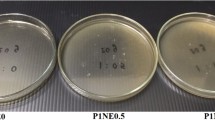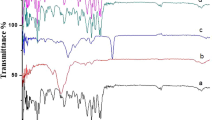Abstract
In this study, solvent-cast polymeric films containing ionic liquid lidocaine/aspirin for transdermal patches were developed. Solvent-cast polymeric films were prepared from two polymers, pectin and Eudragit® NE 30D, by drying the polymeric solution in a hot air oven at 70 ± 3 °C for 10 h. Glycerin was used as a plasticizer. Lidocaine and aspirin were prepared in ionic liquid form and loaded into the patches. The physicomechanical properties of the films were characterized by texture analysis, differential scanning calorimetry, thermogravimetric analysis, and X-ray diffraction. A scanning electron microscope was used to photograph the surfaces of solvent-cast polymeric films. Eudragit® NE 30D significantly decreased the toughness and rigidity of the films. The transdermal patches were in the amorphous state, and their thermal properties were not changed from blank polymeric films. The surfaces of transdermal patches were rougher than blank polymeric films and revealed the distribution of the drug. Eudragit® NE 30D significantly decreased the trends of entrapment efficiency and in vitro release of lidocaine and aspirin drugs. The kinetic release observed in vitro fitted to Higuchi’s model rather than zero and first order models, indicating that a diffusion mechanism governed the release of the drug from the patch. Thus, the solvent-cast polymeric films from two polymers, pectin and Eudragit® NE 30D, are suitable for transdermal patches loaded with ionic liquid lidocaine/aspirin.






Similar content being viewed by others
References
Cilurzo F, Minghetti P, Gennari CGM, Casiraghi A, Montanari L (2010) A novel polymethylmethacrylate hydrophilic adhesive matrix intended for transdermal patch formulations. Drug Deliv 17(3):171–177
Suksaeree J, Charoenchai L, Monton C, Chusut T, Sakunpak A, Pichayakorn W et al (2013) Preparation of a pseudolatex-membrane for ketoprofen transdermal drug delivery systems. Ind Eng Chem Res 52(45):15847–15854
Suksaeree J, Pichayakorn W, Monton C, Sakunpak A, Chusut T, Saingam W (2014) Rubber polymers for transdermal drug delivery systems. Ind Eng Chem Res 53(2):507–513
Pichayakorn W, Suksaeree J, Boonme P, Amnuaikit T, Taweepreda W, Ritthidej GC (2012) Nicotine transdermal patches using polymeric natural rubber as the matrix controlling system: effect of polymer and plasticizer blends. J Membr Sci 411–412:81–90
Pichayakorn W, Suksaeree J, Boonme P, Amnuaikit T, Taweepreda W, Ritthidej GC (2012) Deproteinized natural rubber latex/hydroxypropylmethyl cellulose blending polymers for nicotine matrix films. Ind Eng Chem Res 51(25):8442–8452
Pichayakorn W, Suksaeree J, Boonme P, Taweepreda W, Amnuaikit T, Ritthidej C (2015) Transdermal nicotine mixed natural rubber-hydroxypropylmethylcellulose film forming systems for smoking cessation: In vitro evaluations. Pharm Dev Technol 20(8):966–975
Suksaeree J, Prasomkij J, Panrat K, Pichayakorn W (2018) Comparison of pectin layers for nicotine transdermal patch preparation. Adv Pharm Bull 8(3):401–410
Suksaeree J, Karnsopa P, Wannaphruek N, Prasomkij J, Panrat K, Monton C et al (2018) Use of isolated pectin from a cissampelos pareira-based polymer blend matrix for the transdermal delivery of nicotine. J Polym Environ 26(9):3531–3539
Suksaeree J, Karnsopa P, Wannaphruek N, Prasomkij J, Panrat K, Pichayakorn W (2018) Transdermal delivery of nicotine using pectin isolated from durian fruit-hulls-based polymer blends as a matrix layer. J Polym Environ 26(8):3216–3225
Suksaeree J, Monton C, Madaka F, Chusut T, Saingam W, Pichayakorn W et al (2015) Formulation, physicochemical characterization, and in vitro study of chitosan/HPMC blends-based herbal blended patches. AAPS PharmSciTech 16(1):171–181
Suksaeree J, Charoenchai L, Madaka F, Monton C, Sakunpak A, Charoonratana T et al (2015) Zingiber cassumunar blended patches for skin application: Formulation, physicochemical properties, and in vitro studies. Asian J Pharm Sci 10(4):341–349
Gupta V, Singh S, Srivarstava M, Ahmad H, Pachauri SD, Khandelwal K et al (2016) Effect of polydimethylsiloxane and ethylcellulose on in vitro permeation of centchroman from its transdermal patches. Drug Deliv 23(1):113–122
Boateng JS, Stevens HNE, Eccleston GM, Auffret AD, Humphrey MJ, Matthews KH (2009) Development and mechanical characterization of solvent-cast polymeric films as potential drug delivery systems to mucosal surfaces. Drug Dev Ind Pharm 35(8):986–996
Amrutkar PP, Chaudhari PD, Patil SB (2012) Design and in vitro evaluation of multiparticulate floating drug delivery system of zolpidem tartarate. Coll Surf B Biointerfaces 89:182–187
Kumria R, Nair AB, Al-Dhubiab BE (2014) Loratidine buccal films for allergic rhinitis: development and evaluation. Drug Dev Ind Pharm 40(5):625–631
Kumria R, Nair AB, Goomber G, Gupta S (2016) Buccal films of prednisolone with enhanced bioavailability. Drug Deliv 23(2):471–478
Minghetti P, Cilurzo F, Casiraghi A, Molla FA, Montanari L (1999) Dermal patches for the controlled release of miconazole: influence of the drug concentration on the technological characteristics. Drug Dev Ind Pharm 25(5):679–684
Bica K, Rijksen C, Nieuwenhuyzen M, Rogers RD (2010) In search of pure liquid salt forms of aspirin: ionic liquid approaches with acetylsalicylic acid and salicylic acid. Phys Chem Chem Phys 12(8):2011–2017
Miwa Y, Hamamoto H, Ishida T (2016) Lidocaine self-sacrificially improves the skin permeation of the acidic and poorly water-soluble drug etodolac via its transformation into an ionic liquid. Eur J Pharm Biopharm 102:92–100
Berton P, Di Bona KR, Yancey D, Rizvi SAA, Gray M, Gurau G et al (2017) Transdermal bioavailability in rats of lidocaine in the forms of ionic liquids, salts, and deep eutectic. ACS Med Chem Lett 8(5):498–503
Park HJ, Prausnitz MR (2015) Lidocaine-ibuprofen ionic liquid for dermal anesthesia. AIChE J 61(9):2732–2738
Hough WL, Smiglak M, Rodríguez H, Swatloski RP, Spear SK, Daly DT et al (2007) The third evolution of ionic liquids: active pharmaceutical ingredients. New J Chem 31(8):1429–1436
Pernak J, Sobaszkiewicz K, Mirska I (2003) Anti-microbial activities of ionic liquids. Green Chem 5(1):52–56
Dobler D, Schmidts T, Klingenhöfer I, Runkel F (2013) Ionic liquids as ingredients in topical drug delivery systems. Int J Pharm 441(1):620–627
Maneewattanapinyo P, Suksaeree J (2019) Development and validation of HPLC method for characterization of the acidic and basic drugs prepared into ionic liquid. Lat Am J Pharm 38(5):961–967
Maneewattanapinyo P, Yeesamun A, Watthana F, Panrat K, Pichayakorn W, Suksaeree J (2019) Controlled release of lidocaine–diclofenac ionic liquid drug from freeze-thawed gelatin/poly(vinyl alcohol) transdermal patches. AAPS PharmSciTech 20(8):322
Maneewattanapinyo P, Yeesamun A, Watthana F, Panrat K, Pichayakorn W, Suksaeree J (2020) Transdermal patches of lidocaine/aspirin ionic liquid drug-loaded gelatin/polyvinyl alcohol composite film prepared by freeze-thawed procedure. An Acad Bras Ciênc 92(2):e20191073
Suksaeree J, Maneewattanapinyo P (2020) Ionic liquid drug-based polymeric mtrices for tansdermal dlivery of ldocaine and dclofenac. J Polym Environ 28(10):2771–2779
Rudin A, Choi P (2013). In: Rudin A, Choi P (eds) The elements of polymer science & engineering, 3rd edn. Academic Press, Boston, pp 231–274
Godwin AD (2011). Applied plastics engineering handbook. William Andrew Publishing, Oxford, pp 487–501
Pirayavaraporn C, Rades T, Tucker IG (2012) Determination of moisture content in relation to thermal behaviour and plasticization of Eudragit RLPO. Int J Pharm 422(1):68–74
Yong V, Hahn HT (2007) Moisture absorption modeling using design of experiments. J Appl Polym Sci 103(3):1539–1543
Gupta R, Mukherjee B (2003) Development and in vitro evaluation of diltiazem hydrochloride transdermal patches based on povidone–ethylcellulose matrices. Drug Dev Ind Pharm 29(1):1–7
Ubaidulla U, Reddy MVS, Ruckmani K, Ahmad FJ, Khar RK (2007) Transdermal therapeutic system of carvedilol: effect of hydrophilic and hydrophobic matrix on in vitro and in vivo characteristics. AAPS PharmSciTech 8(1):E13–E20
Desai K-GH, Mallery SR, Holpuch AS, Schwendeman SP (2011) Development and in vitro-in vivo evaluation of fenretinide-loaded oral mucoadhesive patches for site-specific chemoprevention of oral cancer. Pharm Res 28(10):2599–2609
Pendekal SM, Tegginamat KP (2012) Formulation and evaluation of a bioadhesive patch for buccal delivery of tizanidine. Acta Pharm Sin B 2(3):318–324
Ritger PL, Peppas NA (1987) A simple equation for description of solute release II. Fickian and anomalous release from swellable devices. J Control Release 5(1):37–42
Siepmann J, Peppas NA (2001) Modeling of drug release from delivery systems based on hydroxypropyl methylcellulose (HPMC). Adv Drug Deliv Rev 48(2–3):139–157
Acknowledgements
We thank to the Jebsen & Jessen Ingredients (T) Ltd., Thailand for Eudragit® NE 30D as a polymer material in this work and the College of Pharmacy, Rangsit University for financial support. We would also like to acknowledge the contribution of Sutara Pradabwong, Taewee Kantangkul, and Thagorn Chatuthai for their invaluable assistance with the research.
Author information
Authors and Affiliations
Corresponding author
Ethics declarations
Conflict of interest
The authors report no conflicts of interest. The authors alone are responsible for the content and writing of this article.
Additional information
Publisher’s note
Springer Nature remains neutral with regard to jurisdictional claims in published maps and institutional affiliations.
Rights and permissions
About this article
Cite this article
Suksaeree, J., Maneewattanapinyo, P., Panrat, K. et al. Solvent‐Cast Polymeric Films from Pectin and Eudragit® NE 30D for Transdermal Drug Delivery Systems. J Polym Environ 29, 3174–3184 (2021). https://doi.org/10.1007/s10924-021-02108-3
Accepted:
Published:
Issue Date:
DOI: https://doi.org/10.1007/s10924-021-02108-3




